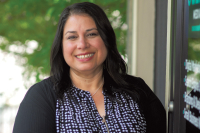Taking stock of our local treasures
By Kathleen Lamont
There has been a lot of planning, talking and meeting lately regarding the buzzword of the decade: “sustainability.”
The first time I saw this word attached to something was 14 years ago when I became involved with the Sustainable Agriculture Movement here in Western North Carolina. Sustainable agriculture means that a farmer uses sustainable growing practices, whether they are organic, biodynamic or permaculture, it matters not. Sustainable means the grower is able to sustain himself and his family and that the soil, considered a living organism, is sustained and added to, not diminished.
On this path, I have met many educated and self-taught folk from whom I have learned. I met Lee Barnes in 1994. Lee is both self-taught and educated in many areas of sustainability and he is definitely one of our local treasures.
Lee Barnes was born and raised in Durham where at a young age he began working in the family trade, a feed and seed farm business.
“My interests stem from a long-term love of working with plants and being a gardener from an early age,” said Lee.
He worked at the store selling bedding plants and bulk seed, so when he began his college studie; his attention was quickly drawn to applied botany.
Receiving his master’s degree in horticulture from North Carolina State University, Lee moved south and obtained his doctorate in environmental horticulture from the University of Florida. Barnes notes a location along the Apalachicola River where a remnant of the Appalachian Mountain flora exists from millions of years ago.
In Florida, Barnes worked with folks who were saving the stinking cedar, a primitive member of the yew family and one of the world’s most endangered conifer trees. The stinking cedar, Torreya taxifolia, is one of the rarest trees in North America. It has a complicated root blight problem that resulted from a combination of fungal pathogens introduced through New Orleans in the 1800s. These pathogens were spread along the cotton trade trail in northern Florida along with a cycle of extreme drought in 1895 that stressed the tree so that secondary fungal organisms appeared. You can learn more about this work at the website at www.torreyaguardians.org.
Barnes found the mountains at an early age through camping and hiking trips with the Boy Scouts and later on, with some hiking chums, convinced his parents to drive them up here from Durham to hike the Appalachian Trail through the Great Smoky Mountains National Park. Lee has completed 4,500 miles of backpacking, having hiked nearly all the trails in the Smokies. He published a small book in 1994 called Smoky Mountain Hiking and Camping. Barnes finally landed in Franklin in the late 1980s, working at the agricultural extension office there and in the early 1990s moved to Waynesville to be closer to Asheville and the environmental/social scene.
Lee became an environmental activist working with the now defunct Katuah Journal, which published from 1984 to1993, focusing on bioregional awareness of the Southern Appalachian Mountains.
A bioregion is a natural system of similar geology, plant and animal communities, and watersheds; fostering the concept of living within your local cycles and developing your own regional resource of food, fiber and fuel.
It was around this time Lee met long time permaculture practitioner Chuck Marsh and took his first permaculture design course at Narrow Ridge, Tenn. According to the ATTRA web page, permaculture is defined as, “Designing ecological human habitats and food production systems. It is a land use and community building movement that strives for the harmonious integration of human dwellings, microclimate, annual and perennial plants, animals, soils, and water into stable, productive communities. The focus is not on these elements themselves, but rather on the relationships created among them by the way we place them in the landscape. This synergy is further enhanced by mimicking patterns found in nature.” For more information, go to the Web site http://attra.ncat.org/attra-pub/perma.html.
In 1994, some folks interested in organic, sustainable, and permaculture growing practices got together and planned the first Summer Gathering held at the Celo Community near Burnsville. At that gathering, Will Hooker, another permaculture enthusiast and horticulture professor at N.C. State University, gave a short demonstration to about 30 of us on dowsing. Lee, with his long history of psychic phenomena and intuition, was inclined to be open to it. As soon as the wire coat hanger rods moved, he was hooked.
After years of attending basic and advanced dowsing classes, he joined the American Society of Dowsers, the British Society of Dowsers, and the Canadian Society of Questers. After three wells came in successfully, Lee decided to make dowsing part of his livelihood. Combining his knowledge of dowsing, horticulture, Permaculture design, sustainable building practices, and obtaining a realtor and broker license, Barnes started Land Stewardship Consulting. He works with small to large landowners assisting them with environmentally sensitive development. He helps them become more aware of the natural plant and animal communities, teaching them how to minimize their disruption of the property, and how to determine which plants are good for wildlife. He also assists them in finding the best house sites suitable for solar exposure and for a proper source of water.
Local treasures are invaluable to a community such as ours — sometimes they are the good news we never hear about.
(Kathleen Lamont is the owner of Back to Basics. Her Web site is www.backtobasicsnc.com and her email is This email address is being protected from spambots. You need JavaScript enabled to view it..)





